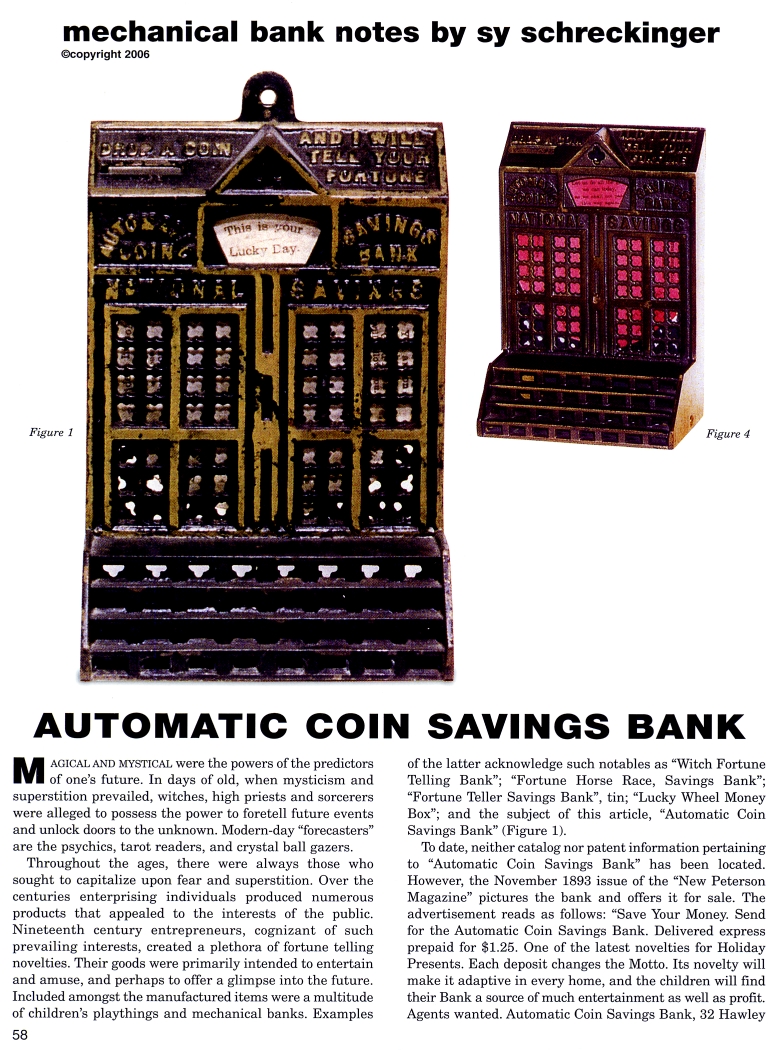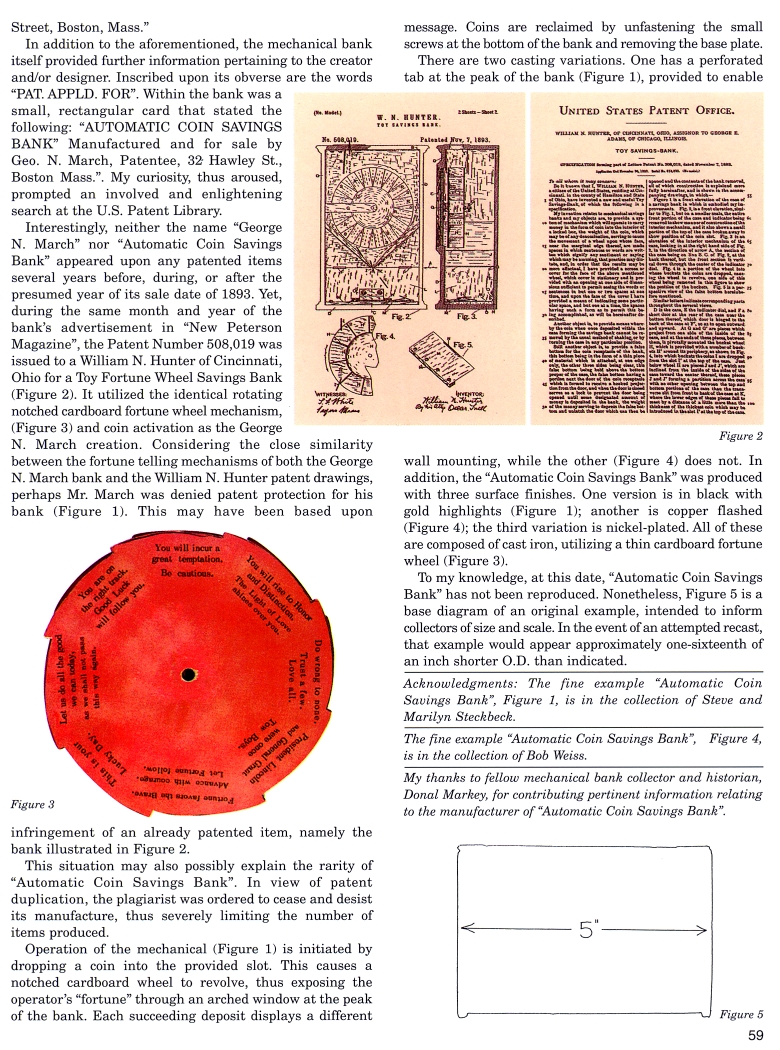|
Automatic Coin Savings
Bank
by Sy Schreckinger – ANTIQUE TOY WORLD Magazine – April, 2006
Magical mystical were the powers of the
predictors of one's future. In days of old, when mysticism and
superstition prevailed, witches, high priests and sorcerers were alleged
to possess the power to foretell future events and unlock doors to the
unknown. Modern-day "forecasters" are the psychics, tarot readers, and
crystal ball gazers.
Throughout the ages, there were always those who sought to capitalize
upon fear and superstition. Over the centuries enterprising individuals
produced numerous products that appealed to the interests of the public.
Nineteenth century entrepreneurs, cognizant of such prevailing interests,
created a plethora of fortune telling novelties. Their goods were
primarily intended to entertain and amuse, and perhaps to offer a glimpse
into the future. Included amongst the manufactured items were a multitude
of children's playthings and mechanical banks. Examples of the latter
acknowledge such notables as "Witch Fortune Telling Bank"; "Fortune Horse
Race, Savings Bank"; "Fortune Teller Savings Bank", tin; "Lucky Wheel
Money Box"; and the subject of this article, "Automatic Coin Savings Bank"
(Figure 1).
To date, neither catalog nor patent information pertaining to
"Automatic Coin Savings Bank" has been located. However, the November 1893
issue of the "New Peterson Magazine" pictures the bank and offers it for
sale. The advertisement reads as follows: "Save Your Money. Send for the
Automatic Coin Savings Bank. Delivered express prepaid for $1.25. One of
the latest novelties for Holiday Presents. Each deposit changes the Motto.
Its novelty will make it adaptive in every home, and the children will
find their Bank a source of much entertainment as well as profit. Agents
wanted. Automatic Coin Savings Bank, 32 Hawley Street, Boston, Mass."
In addition to the aforementioned, the mechanical bank itself
provided further information pertaining to the creator and/or designer.
Inscribed upon its obverse are the words tab at the peak of the bank
(Figure 1), provided to enable "PAT. APPLD. FOR". Within the bank was a
small, rectangular card that stated the following: "AUTOMATIC COIN SAVINGS
BANK" Manufactured and for sale by Geo. N. March, Patentee, 32 Hawley St.,
Boston Mass.". My curiosity, thus aroused, prompted an involved and
enlightening search at the U.S. Patent Library.
Interestingly, neither the name "George N. March" nor "Automatic Coin
Savings Bank" appeared upon any patented items several years before,
during, or after the presumed year of its sale date of 1893. Yet, during
the same month and year of the bank's advertisement in "New Peterson
Magazine", the Patent Number
508,019 was issued to a William N. Hunter of
Cincinnati, Ohio for a Toy Fortune Wheel Savings Bank (Figure 2). It
utilized the identical rotating notched cardboard fortune wheel mechanism,
(Figure 3) and coin activation as the George N. March creation.
Considering the close similarity between the fortune telling mechanisms of
both the George N. March bank and the William N. Hunter patent drawings,
perhaps Mr. March was denied patent protection for his bank (Figure 1).
This may have been based upon infringement of an already patented item,
namely the bank illustrated in Figure 2.
This situation may also possibly explain the rarity of "Automatic Coin
Savings Bank". In view of patent duplication, the plagiarist was ordered
to cease and desist its manufacture, thus severely limiting the number of
items produced.
Operation of the mechanical (Figure 1) is initiated by
dropping a coin into the provided slot. This causes a notched cardboard
wheel to revolve, thus exposing the operator's "fortune" through an arched
window at the peak of the bank. Each succeeding deposit displays a
different message. Coins are reclaimed by unfastening the small screws at
the bottom of the bank and removing the base plate.
There are two casting variations. One has a perforated tab at the
peak of the bank (Figure 1), provided to enable wall mounting, while the
other (Figure 4) does not. In addition, the "Automatic Coin Savings Bank"
was produced with three surface finishes. One version is in black with
gold highlights (Figure 1); another is copper flashed (Figure 4); the
third variation is nickel-plated. All of these are composed of cast iron,
utilizing a thin cardboard fortune wheel (Figure 3).
To my knowledge, at this date, "Automatic Coin Savings Bank" has not
been reproduced. Nonetheless, Figure 5 is a base diagram of an original
example, intended to inform collectors of size and scale. In the event of
an attempted recast, that example would appear approximately one-sixteenth
of an inch shorter O.D. than indicated.
Acknowledgments: The fine example "Automatic Coin Savings Bank",
Figure 1, is in the collection of Steve and Marilyn Steckbeck.
The fine example "Automatic Coin Savings Bank", Figure 4, is in the
collection of Bob Weiss.
My thanks to fellow mechanical bank collector and historian, Donal
Markey, for contributing pertinent information relating to the
manufacturer of "Automatic Coin Savings Bank".
|


